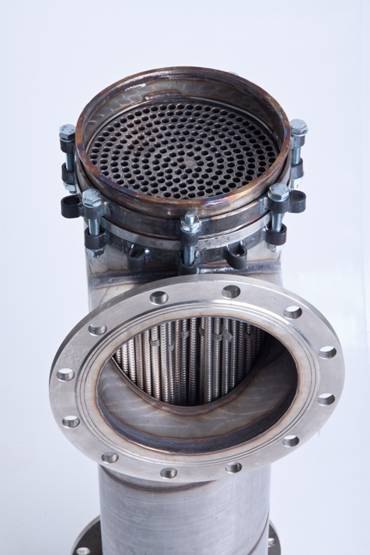High-efficiency tubular heat exchangers
Company JSC "Gandras Energoefektas" establish small-scale production of high-performance tubular heat exchangers, that we are ready to offer to our customers. All calculations are carried out by the Russian research and production institute. Products meet the European standards and has an icon CE.
 While designing the object, we have faced a difficult problem:
While designing the object, we have faced a difficult problem:
- was needed a highly efficient and compact heat exchanger
- had a low hydraulic resistance
- design of the heat exchanger should have let pumping contaminated liquids without scale formation inside the heat exchanger
- a heat exchanger had to be made of steel with grade AISI 316 (was fed by weakly acidic solution).
Performing an analysis of the market of heat exchangers, we encountered the following problems:
Tube heat exchangers:
- existing in large quantities on the market tubular heat exchangers was not characterized by high efficiency
- had large size and as a consequence - the high cost
Plate heat exchangers:
- plate heat exchangers even designed to pass particle size of up to 20mm is not protected from precipitation. As a consequence - the heat exchanger overgrown with particles contained in the solution. It was necessary to build a backwashing system of the heat exchanger, which should once a week for 4 hours to turn if off and wash it, which required: the second heat exchanger and additional pumps.
- heat exchanger in the standard version takes a significant place, and with the backup heat exchanger and backwashing system just could not fit in the existing object.
After examining the existing heat exchangers on the market, we came to the conclusion that we need some kind of "magic" version, that has:
- a high efficiency
- a small size, that allows to carry out any layout (horizontal, vertical, angled) for standart version)
- manufactured from steel AISI 316
- does not accumulate of sediments and does not require flushing
We understood that the apparatus of this class can be used in marine, aviation or aerospace industry. Unfortunately, while analyzing the market of the European Union and the United States, we realized that the cost of such devices is the same "space", and turned to the "native" Navy of the USSR.
What we found:
The analysis carried out showed that the competitive shell and tube heat exchanger must be equipped with profiled tubes, so further heat exchanger with smooth pipes, we have not considered.
However, the tube should have profiled so that hydraulic resistance growth was slightly higher than the growth of heat flow due to the application of turbulators. This is achieved by knurling the outer surface of annular or helical grooves, that cause the formation of smoothly contoured protrusions of reduced height on the inner surface of the tube to intensify the heat transfer tubes. Knurling annular turbulators from the viewpoint of heat transfer is more efficient than a helical groove, because heat transfer coefficient in the tubes can be increased to 2.1-2.5 times compared to 1.4-1.9 times during the growth of the hydraulic resistance of the tube bundle in the 5.0-7.0 times compared to 4.0-6.0 times compared with a smooth tube. For comparison, the use of inserts to swirl flow in pipes, leads to an increase of heat transfer by 30-40% while increasing the pressure loss in 3.5-5.5 times.
Plate heat exchangers wall thickness is up to 0.5 mm and even in the limit of 0.4mm. Everyone knows that the cylindrical shell better resists excessive pressure than the flat wall. So, it is possible to produce tubular heat exchangers, with a pressure of 16 bar. with tubes having a wall thickness of 0.3 mm. (inner diameter of the heat transfer tubes 7.6mm). Obviously, this is less than 0.5 mm and 0.4mm.
If you compare the weight of plate and tubular heat exchangers, we give an example from our practice: we need to heat water with flow 48t / h from 45° C to 63° C (allowable pressure drop of 0.7 bar) with the condensate with the particles and the content of unburned ash with flow 48t / h and the inlet temperature to the heat exchanger 65° C (allowable pressure drop of 0.5 bar). Suggested to solve this problem, a plate heat exchanger has a dry weight equal to 2982kg and tube heat exchanger has a weight equal to 405kg.
As a result, together with the Russian scientists, we had to establish small-scale production of high-performance tubular heat exchangers, that we are ready to offer to our customers. All calculations are carried out by the Russian research and production institute. Products meet the European standards and has an icon CE.



